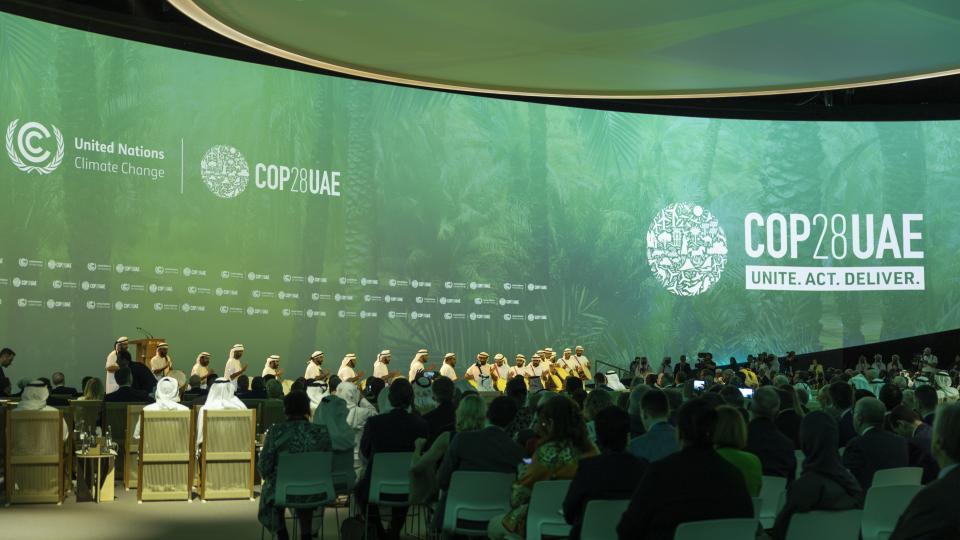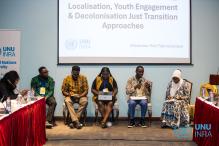As the climate crisis intensifies, we are accelerating towards a point of no return. The planet has just faced 13 straight months of record-breaking temperatures, and the destruction wrought by Hurricane Beryl in the Caribbean has given a small taste of the economic and social turmoil we can expect if the world fails to deliver on the 1.5º target of the Paris Agreement.
While the continued exponential fall in renewable energy costs mark a critical tipping point that can rapidly accelerate a low-carbon transition, the world’s governments remain off-track in their efforts to deliver existing multilateral commitments for addressing climate change and other critical environmental issues such as ecosystem collapse.
As world leaders gather in New York this month for the United Nations (UN) Summit of the Future, citizens across the globe are expecting to see concrete commitments and actions. Building on the UN Secretary General’s Our Common Agenda and the High Level Advisory Board on Effective Multilateralism, the Summit is a "once in a generation" opportunity for reestablishing efficacy, trust and accountability in the multilateral system.
Governments have spent the past 12 months negotiating over the outcome document of the Summit – the Pact for the Future – and its two annexes, the Declaration on Future Generations and the Global Digital Compact. With dedicated multilateral fora already existing for climate change, biodiversity loss, land degradation and other environmental issues, the Summit offers a critical opportunity to articulate how addressing these environmental challenges are deeply connected to other topics the Pact raises, such as reform of the international financial system, strengthening peace and security, promoting digital innovation and empowering youth and future generations.
As negotiations enter their final weeks, this blog post highlights the key actions and commitments that might be expected in the Pact for the Future, identifying significant commitments, mechanisms and areas where governments can still demonstrate ambition and resolve.
A pact that promises a safe planet for the future?
The Pact for the Future reaffirms broad commitments towards tackling climate change, including in securing a new collective quantified goal on climate finance, to be decided at this year’s COP29, which supersedes the previous goal (from 2009) of mobilizing $100 billion per year in climate finance, as well as updating countries’ national climate plans for next year’s COP in Brazil against the pathways set out in last year’s Global Stocktake from COP28.
Following broad calls for its inclusion, the latest draft for the Pact – which reflects language secured in the UAE Consensus – establishes a commitment to decisively transition away from fossil fuels in a just, orderly and equitable manner...
There is notable emphasis on the need for broader international financial reform to improve the mobilization and allocation of climate finance by development banks and other international financial institutions, including through contributions by the private sector in a manner ensuring accountability and integrity. Following broad calls for its inclusion, the latest draft for the Pact – which reflects language secured in the UAE Consensus – establishes a commitment to decisively transition away from fossil fuels in a just, orderly and equitable manner within energy systems, whilst affirming the corresponding international financial and technological support for countries least responsible for historical emissions.

After being notably absent from previous drafts, the core commitment of halting and reversing biodiversity loss by 2030 under the Kunming-Montreal Global Biodiversity Framework is reaffirmed, in support of the long-term goal of "living in harmony with nature". The document remains light on multilateral solutions for strengthening ocean governance or transitioning towards sustainable and resilient food systems, and while it remains conspicuously silent on the matter of the sustainable extraction of the critical minerals required for the green transition, the Pact commits governments towards securing an ambitious international treaty to reduce plastics pollution, expected to be agreed this November in Busan.
Beyond explicit environmental topics, the Pact provides additional momentum towards recent efforts on international financial architecture reform, building on the Paris Summit for a New Global Financing Pact held last year and other efforts by successive G20 Presidencies. This includes initiating a review process of sovereign debt architecture reform inclusive of credit and lending reform for climate-vulnerable countries, governance reform to make the Bretton Woods system more inclusive in its decision-making, capital finance increases by development banks, and the strengthening of the global financial safety net through effective allocation of Special Drawing Rights by the IMF.
Tax reform is also given strong support, including calls for the finalization of a United Nations Framework Convention on International Tax Cooperation, and the exploration of international cooperation to tax high net-worth individuals as called for by the Brazilian G20 Presidency – measures which could dramatically close the gap on climate finance and support financing for loss and damage.
A mix of old stances and new postures
Broader economic policies that are critical for addressing environmental challenges are conspicuously absent: there is no mention of the reallocation of subsidies away from planet-harming activities, in spite of commitments under the Global Biodiversity Framework to reduce harmful subsidies by $500 billion per year by 2030, and as fossil fuel subsidies continue to outpace subsidies for renewable energy.
However, the call within the Pact to initiate a multilateral process starting in 2025 for adopting measures that complement and go beyond GDP represents a potential game-changer for mainstreaming environmental considerations within economic decision-making at international and national levels.
However, the call within the Pact to initiate a multilateral process starting in 2025 for adopting measures that complement and go beyond GDP represents a potential game-changer for mainstreaming environmental considerations within economic decision-making at international and national levels. This effort can support a wider uptake of well-being economics within policymaking and reporting processes that can better account for environmental impacts often discounted within mainstream economic decision-making. It can also support related efforts for promoting sustainable lifestyles, as seen recently at UNEA-6, or sustainable consumption and production patterns such as circular economy approaches that can offer developmental pathways that are aligned with safe and just operating spaces for humanity and the planet.
The draft text of the Pact provides strong commitments to undertake evidence-based policymaking informed by science, and to seize opportunities and manage risks presented by science, technology and innovation. The text also includes strong commitments for international capacity-building efforts to that end, but few details on modalities or fora for doing so. The sanctity of international property rights are reaffirmed, with ambiguous language supporting technology transfers "on mutually agreed terms" – underscoring the challenges of delivering on the rapid dissemination of green technologies in emerging economies, which would help these economies ‘leapfrog’ over carbon-intensive and environmentally-damaging developmental pathways. Only general language is included concerning reform of the international trade system to meet developmental goals, with specific emphasis against the use of unilateral measures – an implicit reference to carbon-border adjustment mechanisms, policy measures which typify the tightrope act in balancing actions that address climate change for the common good while working to maintain international competitive advantages.
Finally, there are two other notable open-ended proposals which remain in the draft text. One calls for the establishment of ad hoc "emergency platforms" set up to help coordinate nimble responses across international bodies to address complex global shocks, such as the COVID-19 pandemic. With growing climate impacts amplifying existing vulnerabilities and creating cascading shocks such as forced migration, conflict and famine, the modalities of these platforms will need to be carefully designed against the ongoing need to address the underlying systemic causes of these emerging shocks. The second proposal calls for governments to explore measures to accelerate implementation and strengthen compliance of existing multilateral environmental agreements at the UN Environment Assembly (UNEA), which takes place biennially in Nairobi. Exploring what concrete measures can help maximize coherence and implementation across the complex ecosystem of environmental treaties, such as a science-policy-action network, as recommended by the HLAB, will be a critical opportunity for UNEA-7 next December.
A declaration that upholds the voice of future generations
The Declaration on Future Generations marks a novel effort at norm-setting for international governance. Building off of previous international instruments that invoke the need to act in accordance with the wellbeing of future generations (such as the 1992 Rio Declaration on Environment and Development and the 1997 UNESCO Declaration on the Responsibility of the Present Generations Towards Future Generations), the Declaration is expected to be an important initiative under the auspices of the General Assembly that articulates precise principles, commitments and actions for governments to adopt in order to safeguard the needs and interests of future generations while delivering those of present generations.
The commitment to safeguard the needs and interests of future generations provides a strong obligation for urgently addressing the climate, biodiversity and pollution crises.
The text incorporates more aspirational language than that of the Pact, including stronger recognition of the rights of Indigenous Peoples, notions of climate justice and the need to address existing structural and systemic causes for present circumstances as a means of building more just and equitable futures. The commitment to safeguard the needs and interests of future generations provides a strong obligation for urgently addressing the climate, biodiversity and pollution crises. However, the absence of a rights-based framing of future generations yields weaker legal obligations under the Declaration to ensure that current decision-making guarantees future generations inherit a stable and healthy planet, as articulated in the recently adopted Maastricht Principles on the Human Rights of Future Generations.
Beyond its normative signalling, the Declaration offers commitments to support the mainstreaming and capacity-building of long-term decision-making both domestically and internationally, as informed by anticipatory measures that support "future-proofing" against shocks, stresses and risks, particularly through the use of strategic foresight and futures thinking. These approaches are increasingly deployed by governments and international institutions in recognition of the growing challenge of planning for policy goals against diverse and complex future scenarios. Recent initiatives such as the UN Futures Lab, the UNEP foresight report, and the OECD Strategic Foresight Unit point to the growing futures literacy that can be mainstreamed through the Declaration. Negotiators will also have the option of encouraging the UN Secretary General to appoint a Special Envoy for Future Generations to help advocate for future generations and support capacity-building for future generations policymaking, similar to the Future Generations Commissioner of Wales.
A compact to secure safe and equitable digital worlds
The Global Digital Compact offers a blueprint for international cooperation to bridge the digital divide and establish mechanisms for promoting the benefits and mitigating the risks of artificial intelligence (AI). With growing evidence of the environmental impacts of information and digital technologies such as water usage for cooling, exploitation of rare earth minerals and growing energy demand for large-scale computing, earlier versions of the Compact included strong commitments to develop and implement sustainability principles for IT and AI technologies to mitigate negative environmental impacts and promote positive sustainability outcomes through their use. However, the most recent version sees a watering down of ambition in favour of general commitments towards "promoting" sustainability across digital technology life cycles, with little obligation towards developing and adopting these principles; it also removed any mention of the role that AI and other digital technologies have in helping address – or contributing towards – climate change.

However, the Compact will likely see strong commitments on developing safeguarding and capacity-building for digital public infrastructure and digital literacy in developing countries, and increasing efforts and financing for SDG data interoperability and monitoring, including through enhancing multi-level data efficiency. As strong data capacity is a critical pillar for the policymaking required for the green transition, improving data interoperability across the SDGs can be an important means of promoting efficiency, transparency and accountability for actions to address climate change and environmental degradation. Furthermore, the Compact calls for open and accessible data systems to support disaster risk responses, which is essential for drastically reducing human and economic losses from climate-induced disasters, as advocated by the UN’s Early Warnings for All initiative.
The road to the Summit and beyond
With negotiations on the Pact for the Future and its two annexes nearing completion, governments will take heed to reflect on whether the Pact they put forward to the world at the Summit on September 22nd will reassure citizens of their countries – who overwhelmingly support rapid action on climate and the environment – that a safe, healthy and liveable planet is bequeathed to present and future generations.
World leaders still have time to ensure that the Pact represents the strongest level of political ambition to show their seriousness in appreciating the dire stakes – and opportunities – the world currently faces in changing our relationship with our planet: where the viability of eradicating poverty within this generation and assuring sustainable and equitable prosperity for future ones is dependent on acting to secure a healthy planet for all.
Suggested citation: Calder Tsuyuki-Tomlinson., "Securing a Pact for the Future that course-corrects for planet and people," UNU-CPR (blog), 2024-09-10, 2024, https://unu.edu/cpr/blog-post/securing-pact-future-course-corrects-planet-and-people.



